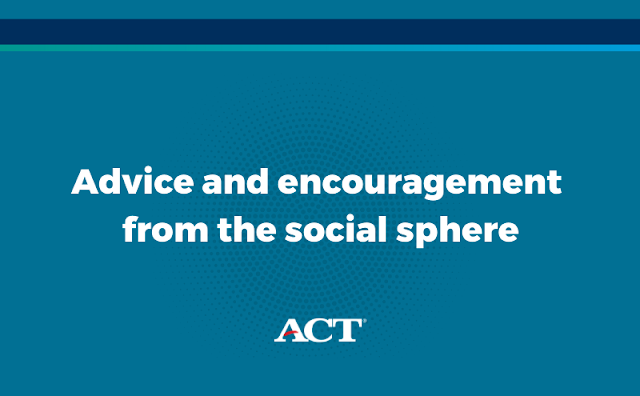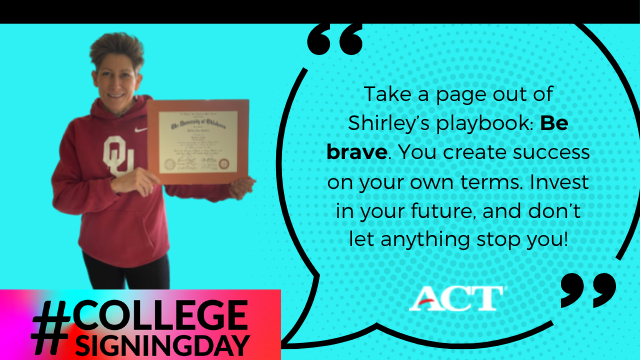 Throughout the month, we’ve celebrated students’ decisions to pursue education and work plans post-high school. May has traditionally been filled with “College Signing Day” celebrations, and this year, after COVID-19 and all its obstacles, students have even more reason to celebrate their futures.
Throughout the month, we’ve celebrated students’ decisions to pursue education and work plans post-high school. May has traditionally been filled with “College Signing Day” celebrations, and this year, after COVID-19 and all its obstacles, students have even more reason to celebrate their futures.It’s an exciting, scary, and emotional time, for all involved! And, no matter what path you choose (two-year, four-year, workforce/CTE, a credentialing program, military, or something else entirely), ACT supports all students finding their best fit on their journey to education and workplace success.
Whether you’ve applied to a program, been accepted and enrolled, or are still figuring out what your path looks like, the following advice can help you along the way.
For the college-goers and college-hopefuls
You have many people in your life—like your teachers, counselors, guardians, and mentors—to help you along the way. Remember three key things: It’s important to create a plan, apply to college(s) that best fit you, and make a decision that feels right for where you are today and where you’d like to be in the future.
Here’s some advice from counselors, educators, and education advocates that they wish their younger selves would have known when they were just starting out:
1.) Create a Plan
"I was lucky because both of my parents attended college. It was always an expectation of my family that I would pursue postsecondary education and they were able to help me navigate the process. If you aren't so lucky, be sure to use your resources, find the right people (i.e. school counselors, advisors, mentors) to help you on your journey, you do not have to do this alone." --Dr. Marci Waldron-Kuhn, ACT State Organizations member
2.) Apply to Colleges that Best Fit You
"My personal college decision played a pivotal role in my success in college, and now my career.
We all have qualities that are unique to us. I am a proud Mexican-American raised by my grandparents in a 'working class' neighborhood in Houston’s northside. Those tough streets cultivated lots of qualities and assets in me that some colleges were not ready to receive.
So, the most important piece of advice I give to my students is that they need to interview the college just as much as the college interviews you. When it’s a bad 'fit' you run the risk of arriving to campus and becoming 'invisible' in the hallways, paths, classrooms, and campus life. It is all about being seen and heard. You want to thrive and bring your voice to campus. Many of the skills that I currently use in my daily work, I learned outside of the class assignments and academic work. I believe and I have witnessed that when students find a college that’s a 'fit' they’re in a better position to maximize their full potential as a person." –Bryan Contreras, vice president, myOptions
BONUS TIP: "Apply early! I wish I would've applied to college sooner. I waited until the last minute, because I was undecided, and missed out on a lot of financial aid. I wish I would have applied early and given myself time to make a last minute decision without it impacting my financial aid package." --Summer Gortney, Kentucky state coordinator for American College Application Campaign
3.) Make A Decision that Feels Right Now (with Later in Mind)
"As a career coach, I understand that choosing a career is sometimes a difficult decision for your life's journey.
I personally discovered that a defining moment can give you the answer to help you choose a career.
When I was thinking about what I wanted to study in college, I remembered that I did not understand how my parents owed so much in taxes but were below the poverty earnings. I realized I wanted to become an accountant to help people understand about taxes and finance." --Michael Burnside, director of career services for Atlanta Technical College, ACT State Organizations member
"Remember that you are going to work for the next 30, 40, or 50 years. Find something that you are passionate about. Work towards a degree that will allow you to feel motivated and meet your goals. When work is something that you love doing, you never work a day in your life." -- Chad Bartlett, director of organizational strategy, data, and policy, Green Hills AEA (Iowa), ACT State Organizations member
For the “credentials or career” crew
You, too, have many mentors and advocates rooting for you, even if you don’t know them personally. Remember that you don’t have to take a “traditional” path. No one knows you, your passions, and your skills better than you do! Introspection and self-discovery will serve you well.
1.) Use Your Skills as a Starting Point
"Over 94% of Americans over the age of 25 have received their high school diploma or equivalent (according to NCES). While that is a fantastic number, it now means you must compete with 94% of the population for a job. What sets you apart from the crowd? You need something your employer can "hang their hat on," so-to-speak. Committing to a degree, apprenticeship, or certification beyond high school will show potential employers that you have already invested in yourself and your employability."-- Skye Feather, academic advisor, Pierpont Community & Technical College
2.) Take Time for Personal Discovery…and Research
"Take an interest inventory to see how your innate interests align to different career options. Look into what the job market is for the careers you're interested in. Then consider what training is needed and who is providing the training to enter that career path." -- an associate vice president of workforce development, ACT State Organizations member
"Remain open minded. Your exposure to all that is available might be limited at the moment, so it might not be reflective of every opportunity that you can access. Be willing to ask questions and learn from multiple experts, rather than only reading or listening to one resource. Completing an application, attending a meeting, reading a brochure, or listening to a presentation is not a commitment—it is getting informed. Take action, follow through, and start saving forms, pamphlets, and messages in an 'after high school plans' bin or file folder so you will have them saved for when you need them." –Sheryl Smith, counselor, Auburn City Schools, ACT State Organizations member
I am blessed to have earned my education at @CCSU and remember vividly when I chose this school. For all students choosing to continue their education, I wish you the best of luck - I can’t wait to see the great things you accomplish. #CollegeSigningDay pic.twitter.com/9cxwdp5J1t
— Secretary Miguel Cardona (@SecCardona) May 1, 2021
#CollegeDecisionDay looked different for a lot of schools this year. We applaud schools like Hillsdale High School who are finding pandemic-safe ways to celebrate their students’ postsecondary plans. pic.twitter.com/AaYQL0qyf0
— MCAN (@MICollegeAccess) May 21, 2021
Congratulations, Class of 2021!
— Detroit College Access Network (DCAN) (@Detroit_CAN) May 7, 2021
We are so excited to share our #DetroitDecisionDay video to celebrate the decisions that Detroit seniors made for their postsecondary education.
Please join us in wishing all the best to our #collegebound students! 🎉https://t.co/tABbfSLqfj
College gives you the tools you need to change your future and help your community 👏🏾 That’s right, @TheAmandaGorman! #CollegeSigningDay pic.twitter.com/uk7jW0gpLS
— Better Make Room 🎓 (@BetterMakeRoom) May 1, 2021
Senior Decision Day!! @HighPermian @Permian_GoMOJO @GenerationTexas pic.twitter.com/w93vjIVeub
— Jennifer Perkins (@Jennife74581412) May 14, 2021
We're celebrating #CollegeSigningDay all month long! Congratulations to the #Classof2021 on committing to your future education and careers! #WhyApply #IApplied @ReachHigher @BetterMakeRoom pic.twitter.com/biQD5g8tPd
— ACT Equity (@ACTEquity) May 10, 2021
🤩💜 Concluded @GenerationTexas Decision Week by having a drive-by filled with cakes, commitment certificates & cheerful faces! Congratulations @Eastlake_HS Class of 2021 🤩💜#TeamSISD pic.twitter.com/jvkro3agNm
— Eastlake Go Center (@EHS_GoCenter) May 8, 2021
Its important remember that even though the CHE College & Career Decision Month celebration concludes today, we should continue to support and celebrate our Seniors as they take the next step. Keep sharing those posts even after today and I will do the same. Way to go c/o '21 https://t.co/wI4T6hqvUx
— SC CAN GO (@SCCANGO) May 14, 2021
Congratulations, Da'Shaun! @mcacampaign #classof2021 #MDCollegeStrong #homegrown #ColonelTOUGH pic.twitter.com/GuDidYmymh
— Colonel Richardson High School (@CRcolonels) May 5, 2021
Mingo Central’s “Transition to College Event” was successful! Our graduates are #CollegeBound 🎓🎉 @WVGEARUP pic.twitter.com/sdhwDjYm4v
— MCHS Counselors (@MingoCounseling) May 6, 2021
It’s our seniors last day and we want to highlight their College Decision Day in honor of their accomplishments and future plans! 🎉 We are so proud of these young men and women, and so excited to see what their future holds! Congratulations, class of 2021! 🎓Ⓜ️ @WVGEARUP pic.twitter.com/0XVayPa0rd
— MCHS Counselors (@MingoCounseling) May 20, 2021
And for all of the high school graduates out there, no matter your postsecondary path:
"Work hard, study hard, be responsible, but make certain to take time to unwind." –Mike Sharp, principal, Kofa High School, ACT State Organizations member
You’ve earned the celebration! Throw your cap high and enjoy the moment. Congratulations, graduates!
Recommended Reading:
- ‘Be Brave’ and ‘Do it For Yourself’: Career Success is Attainable at Any Age
- How Students Can Dream, Plan, and Learn to See Setbacks as Set-Ups for Opportunity
- Community Colleges: Promising Pathways for Challenging Times


























